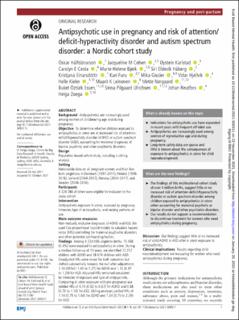| dc.contributor.author | Halfdanarson, Oskar | |
| dc.contributor.author | Cohen, Jacqueline Mallory | |
| dc.contributor.author | Karlstad, Øystein | |
| dc.contributor.author | Cesta, Carolyn E. | |
| dc.contributor.author | Bjørk, Marte-Helene | |
| dc.contributor.author | Håberg, Siri Eldevik | |
| dc.contributor.author | Einarsdottir, Kristjana | |
| dc.contributor.author | Furu, Kari | |
| dc.contributor.author | Gissler, Mika | |
| dc.contributor.author | Hjellvik, Vidar | |
| dc.contributor.author | Kieler, Helle | |
| dc.contributor.author | Leinonen, Maarit | |
| dc.contributor.author | Nørgaard, Mette | |
| dc.contributor.author | Essen, Buket Öztürk | |
| dc.contributor.author | Ulrichsen, Sinna Pilgaard | |
| dc.contributor.author | Reutfors, Johan | |
| dc.contributor.author | Zoega, Helga | |
| dc.date.accessioned | 2022-01-21T07:34:25Z | |
| dc.date.available | 2022-01-21T07:34:25Z | |
| dc.date.created | 2022-01-20T09:07:24Z | |
| dc.date.issued | 2021 | |
| dc.identifier.citation | Evidence-Based Mental Health. 2021, 1-9. | |
| dc.identifier.issn | 1362-0347 | |
| dc.identifier.uri | https://hdl.handle.net/11250/2838582 | |
| dc.description.abstract | Abstract Background Antipsychotics are increasingly used among women of childbearing age and during pregnancy. Objective To determine whether children exposed to antipsychotics in utero are at increased risk of attention-deficit/hyperactivity disorder (ADHD) or autism spectrum disorder (ASD), accounting for maternal diagnoses of bipolar, psychotic and other psychiatric disorders. Design Population-based cohort study, including a sibling analysis. Setting Nationwide data on all pregnant women and their live-born singletons in Denmark (1997-2017), Finland (1996-2016), Iceland (2004-2017), Norway (2004-2017), and Sweden (2006-2016). Participants 4 324 086 children were eligible for inclusion to the study cohort. Intervention Antipsychotic exposure in utero, assessed by pregnancy trimester, type of antipsychotic, and varying patterns of use. Main outcome measures Non-mutually exclusive diagnoses of ADHD and ASD. We used Cox proportional hazard models to calculate hazard ratios (HRs) controlling for maternal psychiatric disorders and other potential confounding factors. Findings Among 4 324 086 singleton births, 15 466 (0.4%) were exposed to antipsychotics in utero. During a median follow-up of 10 years, we identified 72 257 children with ADHD and 38 674 children with ASD. Unadjusted HRs were raised for both outcomes but shifted substantially towards the null after adjustment; 1.10 (95%CI 1.00 to 1.27) for ADHD and 1.12 (0.97 to 1.29) for ASD. Adjusted HRs remained consistent by trimester of exposure and type of antipsychotic. Comparing in utero exposure with pre-pregnancy use yielded HRs of 0.74 (0.62 to 0.87) for ADHD and 0.88 (0.70 to 1.10) for ASD. Sibling analyses yielded HRs of 1.14 (0.79 to 1.64) for ADHD and 1.34 (0.75 to 2.39) for ASD. Discussion Our findings suggest little or no increased risk of child ADHD or ASD after in utero exposure to antipsychotics. Clinical implications Results regarding child neurodevelopment are reassuring for women who need antipsychotics during pregnancy. | |
| dc.language.iso | eng | |
| dc.title | Antipsychotic use in pregnancy and risk of attention/deficit-hyperactivity disorder and autism spectrum disorder: a Nordic cohort study | |
| dc.type | Peer reviewed | |
| dc.type | Journal article | |
| dc.description.version | publishedVersion | |
| dc.source.pagenumber | 1-9 | |
| dc.source.journal | Evidence-Based Mental Health | |
| dc.identifier.doi | 10.1136/ebmental-2021-300311 | |
| dc.identifier.cristin | 1985643 | |
| dc.relation.project | Norges forskningsråd: 262700 | |
| cristin.ispublished | true | |
| cristin.fulltext | original | |
| cristin.qualitycode | 1 | |
